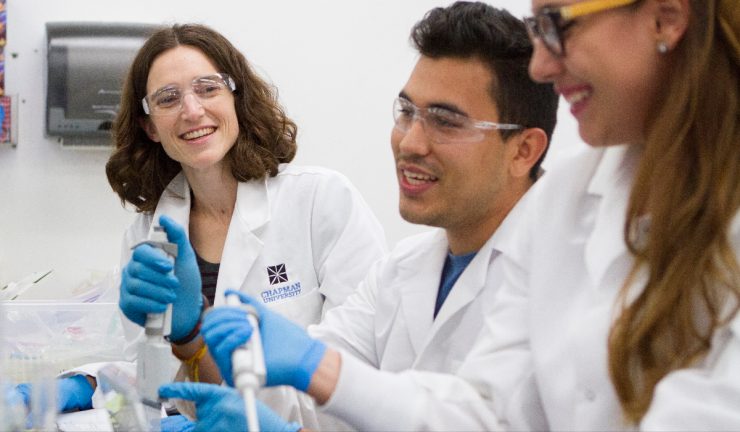On a hook or in a net, red snapper isn’t difficult to distinguish from rockfish or tilapia. But once the fish are filleted, they become hard to tell apart, making it easy for the unscrupulous to slip imposters past the typical guards of consumer protection.
Just how easy? Well, a recent study by Professor Rosalee Hellberg and the Food Protection Lab at Chapman University found that 92% of retail samples labeled as red snapper were in fact a different species. Molecular testing identified them as mahi mahi, rockfish, tilapia or other snapper species. Definitely not what shoppers were paying extra to get.
“There are a lot of issues and a lot of consequences of food fraud,” says Hellberg, Ph.D., associate professor of food science in Chapman’s Schmid College of Science and Technology. Hellberg’s research, which focuses on rapid methods for detection of food fraud and food contaminants, has greatly benefited from the university’s Faculty Opportunity Fund.
Faculty Opportunity Fund Supports Emerging Research
Launched in 2017, the fund supports Chapman research and creative activity as the researchers also pursue external funding. Over its three-year existence, the Faculty Opportunity Fund has seeded dozens of projects with awards of up to $15,000.
“The goal is to provide our faculty with opportunities to catalyze new and innovative areas of exploration,” says Vice President for Research Thomas Piechota, Ph.D., whose office oversees the fund. “We want to expand the base of competitive research, scholarship and creative activity so we can elevate our scholars’ national visibility and increase their external support.”
For Hellberg and the Food Protection Lab, the funding helped support research that included advances in multimode hyperspectral imaging and real-time polymerase chain reaction (PCR) technology to reveal undeclared species in food products. In addition to testing seafood, the lab applies its molecular techniques to root out unlabeled ingredients in pet foods, game meats and dietary supplements.
“It’s rewarding to expose where cheating is going on in the (food) industry and to share that with consumers as well as regulatory agencies.” — Rosalee Hellberg, who leads Chapman’s Food Protection Lab
The Grocery Manufacturers Association estimates that consumer product fraud costs U.S. manufacturers as much as $15 billion a year.
“Fraud has been found to happen at all levels of the supply chain,” says Hellberg, who previously worked for the federal Food and Drug Administration. “As you move farther down the chain, you’ll find a higher percentage of fraud.”
Collaboration Helps Expose Dishonest Dealers
Sometimes the mislabeling is inadvertent, but often it’s the work of dishonest dealers substituting cheaper species for financial gain, Hellberg says. She and her lab team, which includes graduate and undergraduate students, often collaborate with scientists at enforcement agencies and publish their findings in peer-reviewed journals.
“It’s rewarding to expose where cheating is going on in the industry and to share that with consumers as well as regulatory agencies,” says Hellberg, who in 2017 received the Emerging Leaders Network Award from the Institute of Food Technologists. She also has earned Chapman’s Wang-Fradkin Assistant Professorship Award, the university’s highest honor for research, and she is the lead editor of the upcoming book “Food Fraud: A Global Threat With Public Health and Economic Consequences.”
Those health threats include food allergies triggered by unlabeled ingredients, as well as exposure to foodborne pathogens and toxins. In addition, sometimes food fraud research identifies threatened or endangered species in consumer products, Hellberg says.
Red snapper is a particular target for fraud because it is highly valued and in limited supply because of overfishing, she says.
“Thanks to the Faculty Opportunity Fund, we’ve been able to conduct research that shows widespread mislabeling of red snapper and further develop techniques to improve fraud detection,” Hellberg notes.
That internal support has led to the acquisition of federal funding, including from the National Oceanographic and Atmospheric Administration for a project involving multimode hyperspectral imaging for food quality and safety.
The lab’s promising results with a benchtop imager support its goal of developing a handheld imager for rapid screening of fish species.
“We learn more with every new study we do,” Hellberg says.
Learn More
Learn more about Chapman University’s MS in Food Science program.




